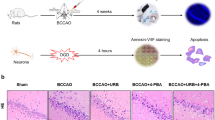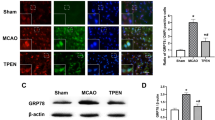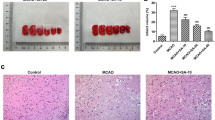Abstract
Simvastatin is a cholesterol-lowering agent whose functional significance and neuroprotective mechanism in ischemic brain injury is not yet solved. The purpose of this study is to evaluate the effect of simvastatin on ischemic brain injury. We examined the endoplasmic reticulum stress response (UPR/unfolded protein response), by measuring the mRNA and protein levels of specific genes such as ATF6, GRP78, and XBP1 after 15 min 4-VO ischemia and different times of reperfusion (1, 3, and 24 h). The results from the group of naïve ischemic rats were compared with results from the group of pre-treated animals with simvastatin. The results of the experiments showed significant increase in all genes at the mRNA level in ischemic phase (about 43% for XBP1, 58% for GRP78, and 39% for ATF6 more than control). The protein level of XBP1 was decreased in pre-treated animals at ischemic phase and first hour of reperfusion (about 15% less), and did not reach control levels. The protein levels of GRP78 were maximal at third hour of reperfusion in statin group with a small decrease at 24 h of reperfusion in both groups. The levels of ATF6 mRNA in statin-treated animals was higher in comparison to non-statin animals at the ischemic phase and the third hour of reperfusion (about 35% higher), which was also translated into the higher protein level. This could indicate that one of the main proteins targeted to enhance neuroprotective effect to ER during the first two hours of reperfusion was ATF6 protein, the levels of which were 60% higher than in non-treated animals. These data suggest that simvastatin, in addition to the proposed neuroprotective effect, exerts a neuroprotective role in the attenuation of ER stress response after acute ischemic/reperfusion insult.







Similar content being viewed by others
References
Adachi Y, Yamamoto K, Okada T, Yoshida H, Harada A, Mori K (2008) ATF6 is a transcription factor specializing in the regulation of quality control proteins in the endoplasmic reticulum. Cell Struct Funct 33:75–89. doi:10.1247/csf.07044
Amin-Hanjan S, Stagliano NE, Yamada M, Huang PL, Liao JK, Moskowitz MA (2001) Mevastatin, an HMG-CoA reductase inhibitor, reduces stroke damage and upregulates endothelial nitric oxide synthase in mice. Stroke 32:980–986
Aoki M, Tamatani M, Taniguchi M, Yamaguchi A, Bando Y, Kasai K et al (2001) Hypothermic treatment restores glucose regulated protein 78 (GRP78) expression in ischemic brain. Brain Res Mol Brain Res 95(1–2):117–128. doi:10.1016/S0169-328X(01)00255-8
Balduini W, Mazzoni E, Carloni S, De Simoni MG, Perego C, Sironi L (2003) Prophylactic but not delayed administration of simvastatin protects against long-lasting cognitive and morphological consequences of neonatal hypoxic-ischemic brain injury, reduces interleukin-1beta and tumor necrosis factoralpha mRNA induction, and does not affect endothelial nitric oxide synthase expression. Stroke 34:2007–2012. doi:10.1161/01.STR.0000080677.24419.88
Bucelli RC, Gonsiorek EA, Kim WY, Bruun D, Rabin RA, Higgins D et al (2008) Statins decrease expression of the proinflammatory neuropeptides calcitonin gene-related peptide and substance P in sensory neurons. J Pharmacol Exp Ther 324(3):1172–1180. doi:10.1124/jpet.107.132795
Burda J, Hrehorovska M, García BL, Danielisova V, Cízkova D, Burda R et al (2003) Role of protein synthesis in the ischemic tolerance acquisition induced by transient forebrain ischemia in the rat. Neurochem Res 28:1237–1243. doi:10.1023/A:1024232513106
Byington RP, Davis BR, Plehn JF, White HD, Baker J, Cobbe SM (2001) Reduction of stroke events with pravastatin: the Prospective Pravastatin Pooling (PPP) Project. Circulation 103:387–392
Calfon M, Zeng H, Urano F, Till JH, Hubbart SR, Harding HP et al (2002) IRE1 couples endoplasmic reticulum load to secretory capacity by processing XBP-1 mRNA. Nature 415:92–96. doi:10.1038/415092a
Cimino M, Balduini W, Carloni S, Gelosa P, Guerrini U, Tremoli E et al (2005) Neuroprotective effect of simvastatin in stroke: a comparison between adult and neonatal rat models of cerebral ischemia. Neurotoxicology 26:929–933. doi:10.1016/j.neuro.2005.03.009
Coimbra C, Wieloch T (1994) Moderate hypothermia mitigates neuronal damage in the rat brain when initiated several hours following transient cerebral ischemia. Acta Neuropathol 87:325–331. doi:10.1007/BF00313599
DeGracia DJ, Montie HL (2004) Cerebral ischemia and the unfolded protein response. J Neurochem 91(1):1–8. doi:10.1111/j.1471-4159.2004.02703.x
DeGracia DJ, Kumar R, Owen CR, Krause GS, White BC (2002) Molecular pathways of protein synthesis inhibition during brain reperfusion: implications for neuronal survival or death. J Cereb Blood Flow Metab 22:127–141. doi:10.1097/00004647-200202000-00001
De la Vega MC, Burda J, Nemethova M, Quevedo C, Alcazar A, Martin ME et al (2001) Possible mechanisms involved in the down-regulation of translation during transient global ischaemia in the rat brain. Biochem J 357:819–826. doi:10.1042/0264-6021:3570819
García L, Burda J, Hrehorovska M, Burda R, Martin E, Salinas M (2004) Ischaemic preconditioning in the rat brain: effect on the activity of several initiation factors, Akt and extracellular signal-regulated protein kinase phosphorylation, and GRP78and GADD34 expression. J Neurochem 88:136–147
Gertz K, Laufs U, Lindauer U, Nickenig G, Bohm M, Dirnagl U et al (2003) Withdrawal of statin treatment abrogates stroke protection in mice. Stroke 34:551–557. doi:10.1161/01.STR.0000054055.28435.BF
Gidday JM (2006) Cerebral preconditioning and ischaemic tolerance. Nat Rev Neurosci 7(6):437–448. doi:10.1038/nrn1927
Harding HP, Zhang Y, Ron D (1999) Protein translation and folding are coupled by an endoplasmic reticulum-resident kinase. Nature 397:271–274. doi:10.1038/16729
Hayashi T, Saito A, Okuno S, Ferrand-Drake M, Dodd RL, Nishi T et al (2003) Oxidative damage to the endoplasmic reticulum is implicated in ischemic neuronal cell death. J Cereb Blood Flow Metab 23:1117–1128. doi:10.1097/01.WCB.0000089600.87125.AD
Hayashi T, Hamakawa K, Nagotani S, Jin G, Li F, Deguchi K et al (2005) HMG CoA reductase inhibitors reduce ischemic brain injury of Wistar rats through decreasing oxidative stress on neurons. Brain Res 1037(1–2):52–58. doi:10.1016/j.brainres.2004.12.051
Haze K, Yoshida H, Yanagi H, Yura T, Mori K (1999) Mammalian transcription factor ATF6 is synthesized as a transmembrane protein and activated by proteolysis in response to endoplasmic reticulum stress. Mol Biol Cell 10:3787–3799
Imaizumi K, Katayama T, Tohyama M (2001) Presenilin and the UPR. Nat Cell Biol 3:E104. doi:10.1038/35074613
Johnson-Anuna LN, Eckert GP, Keller JH, Igbavboa U, Franke C, Fechner T et al (2005) Chronic administration of statins alters multiple gene expression patterns in mouse cerebral cortex. J Pharmacol Exp Ther 312(2):786–793. doi:10.1124/jpet.104.075028
Kudo T, Kanemoto S, Hara H, Morimoto N, Morihara T, Kimura R et al (2008) A molecular chaperone inducer protects neurons from ER stress. Cell Death Differ 15(2):364–375. doi:10.1038/sj.cdd.4402276
Kumar R, Azam S, Sullivan JM, Owen C, Cavener DR, Zhang P et al (2001) Brain ischemia and reperfusion activate the eukaryotic initiation factor 2a kinase, PERK. J Neurochem 77:1418–1421. doi:10.1046/j.1471-4159.2001.00387.x
Kumar R, Krause GS, Yoshida H, Mori K, DeGracia DJ (2003) Dysfunction of the unfolded protein response during global brain ischemia and reperfusion. J Cereb Blood Flow Metab 23:462–471. doi:10.1097/00004647-200304000-00010
Lehotský J, Murín R, Strapková A, Uríková A, Tatarková Z, Kaplán P (2004) Time course of ischemia/reperfusion-induced oxidative modification of neural proteins in rat forebrain. Gen Physiol Biophys 23(4):401–415
Morimoto N, Oida Y, Shimazawa M, Miura M, Kudo T, Imaizumi K et al (2007) Involvement of endoplasmic reticulum stress after middle cerebral artery occlusion in mice. Neuroscience 147(4):957–967. doi:10.1016/j.neuroscience.2007.04.017
Nagotani S, Hayashi T, Sato K, Zhang W, Deguchi K, Nagano I et al (2005) Reduction of cerebral infarction in stroke-prone spontaneously hypertensive rats by statins associated with amelioration of oxidative stress. Stroke 36(3):670–672. doi:10.1161/01.STR.0000155732.27333.3c
Ohtsuki T, Reutzler CA, Tasaki K, Hallenbeck JM (1996) Interleukin-1 mediates induction of tolerance to global ischemia in gerbil hippocampal CA1 neurons. J Cereb Blood Flow Metab 16:1137–1142. doi:10.1097/00004647-199611000-00007
Oyadomari S, Mori M (2004) Roles of CHOP/GADD153 in endoplasmic reticulum stress. Cell Death Differ 381:381–389. doi:10.1038/sj.cdd.4401373
Paschen W (2003a) Endoplasmic reticulum: a primary target in various acute disorders and degenerative diseases of the brain. Cell Calcium 34:365–383. doi:10.1016/S0143-4160(03)00139-8
Paschen W (2003b) Shutdown of translation: lethal or protective? Unfolded protein response versus apoptosis. J Cereb Blood Flow Metab 23:773–779. doi:10.1097/01.WCB.0000075009.47474.F9
Pulsinelli WA, Brierley JB, Plum F (1982) Temporal profile of neuronal damage in a model of transient forebrain ischemia. Ann Neurol 11(5):491–498. doi:10.1002/ana.410110509
Qi X, Okuma Y, Hosoi T, Nomura Y (2004) Edaravone protects against hypoxia/ischemia-induced endoplasmic reticulum dysfunction. J Pharmacol Exp Ther 311:388–393. doi:10.1124/jpet.104.069088
Shabanzadeh AP, Shuaib A, Wang CX (2005) Simvastatin reduced ischemic brain injury and perfusion deficits in an embolic model of stroke. Brain Res 1042(1):1–5. doi:10.1016/j.brainres.2005.01.105
Shen X, Ellis RE, Lee K, Liu CY, Yang K, Solomon A et al (2001) Complementary signaling pathways regulate the unfolded protein response and are required for C. elegans development. Cell 107:893–903. doi:10.1016/S0092-8674(01)00612-2
Sironi L, Cimino M, Guerrini U, Calvio AM, Lodetti B, Asdente M (2003) Treatment with statins after induction of focal ischemia in rats reduces the extent of brain damage. Arterioscler Thromb Vasc Biol 23:322–327. doi:10.1161/01.ATV.0000044458.23905.3B
Sivonová M, Kaplán P, Duracková Z, Dobrota D, Drgová A, Tatarková Z et al (2008) Time course of peripheral oxidative stress as consequence of global ischaemic brain injury in rats. Cell Mol Neurobiol 28(3):431–441. doi:10.1007/s10571-007-9246-x
Takemoto M, Liao JK (2001) Pleiotropic effects of 3-hydroxy-3-methylglutaryl coenzyme a reductase inhibitors. Arterioscler Thromb Vasc Biol 21:1712–1719. doi:10.1161/hq1101.098486
Uríková A, Babusíková E, Dobrota D, Drgová A, Kaplán P, Tatarková Z et al (2006) Impact of Ginkgo Biloba Extract EGb 761 on ischemia/reperfusion–induced oxidative stress products formation in rat forebrain. Cell Mol Neurobiol 26:1343–1353. doi:10.1007/s10571-006-9030-3
Vaughan CJ, Delanty N (1999) Neuroprotective properties of statins in cerebral ischemia and stroke. Stroke 30:1969–1973
Vaughan CJ, Delanty N, Basson CT (2001) Statin therapy and stroke prevention. Curr Opin Cardiol 16:219–224. doi:10.1097/00001573-200107000-00001
Yoshida H, Matsui T, Yamamoto A, Okada T, Mori K (2001) XBP1 mRNA is induced by ATF6 and spliced by IRE1 in response to ER stress to produce a highly active transcription factor. Cell 107:881–891. doi:10.1016/S0092-8674(01)00611-0
Yoshida H, Matsui T, Hosokawa N, Kaufman RJ, Nagata K, Mori K (2003) A time-dependent phase shift in the mammalian unfolded protein response. Dev Cell 4:265–271. doi:10.1016/S1534-5807(03)00022-4
Yu ZW, Lou H, Fu W, Mattson MP (1999) The endoplasmic reticulum stress-responsive protein GRP78 protects neurons against excitotoxicity and apoptosis: Suppression of oxidative stress and stabilization of calcium homeostasis. Exp Neurol 155:302–314. doi:10.1006/exnr.1998.7002
Acknowledgments
This work was supported by grants VEGA 3380/06 and 0027/08, MVTS-COST B30, VVCE0064-07-06, from the Ministry of Education and Science of the Slovak Republic and European Social Fund SORO 328/2005. P.U. is grateful to prof. L. Kaczmarek, Nencki Institute, Warsaw, Poland, for his hospitality.
Author information
Authors and Affiliations
Corresponding author
Rights and permissions
About this article
Cite this article
Urban, P., Pavlíková, M., Sivonová, M. et al. Molecular Analysis of Endoplasmic Reticulum Stress Response After Global Forebrain Ischemia/Reperfusion in Rats: Effect of Neuroprotectant Simvastatin. Cell Mol Neurobiol 29, 181–192 (2009). https://doi.org/10.1007/s10571-008-9309-7
Received:
Accepted:
Published:
Issue Date:
DOI: https://doi.org/10.1007/s10571-008-9309-7




